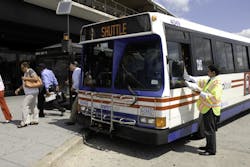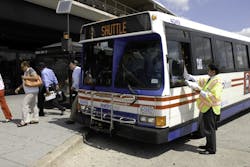One of the biggest challenges ahead for reauthorizing transportation funding in the U.S. revolves around the shrinking amount of overall money available for highways, railways, and especially public transportation endeavors.
Needless to say, with fuel tax revenues continuing to fall, major transportation constituencies – from trucking and rail on down to the public buses plying our city streets – are all working to demonstrate the value they bring the nation’s economy so they don’t get the short end of the funding stick.
[To go on a quick tangent: take a look at how Europe is trying to reconfigure its public networks to be more efficient in the future in the video below.]
In the case of public transit, the American Public Transportation Association (APTA) tapped consulting firm Economic Development Research Group, Inc., to craft a big study bolstering what APTA believes is the “value proposition” of public bus, subway, and light rail networks.
That study – entitled the Economic Impact of Public Transportation Investment – concludes that investment in public transportation will lead to 50,700 jobs per $1 billion invested, with 28,900 jobs per $1 billion attributed to the productivity gains enjoyed by households and businesses. Overall, investment in public transportation offers an economic return of $4 for every $1 invested, APTA claims based on the study’s findings.Now, how does public transit investment achieve such benefits? APTA’s study points to two areas: first from reduced congestion and less reliance on automobile use, saving some $18.4 billion per year, while second reducing congestion costs and logistics – savings that contribute an additional $10.1 billion to the U.S. economy.
[The group also offers some other policy suggestions regarding public transit strategy in this country, which you view by clicking here.]
In addition, APTA said “enhanced productivity” and improved labor-force access results in $3.3 billion per year in increased tax revenue for the federal government, along with a $1.1 billion tax boost for state and local governments.
An additional $6 billion in tax revenue, annually, comes from the traditional impact of spending, with $2.2 billion going to state and local governments and $3.8 billion going to the federal government. Total tax receipts are estimated at $10.4 billion per year, APTA said.
Certainly not everyone will agree with the APTA’s conclusions, but regardless, this study’s data will be added to the big transportation funding debate now taking place on Capitol Hill – and how it might ultimately affect that debate is anyone’s guess.

